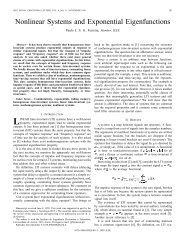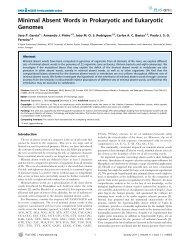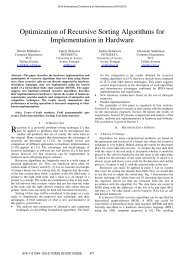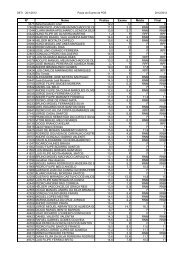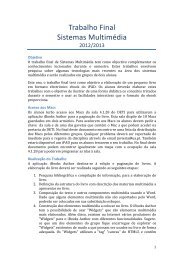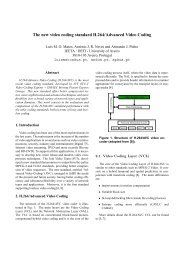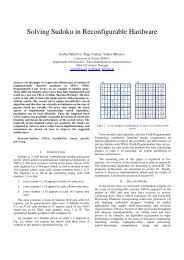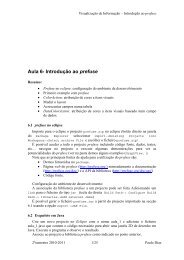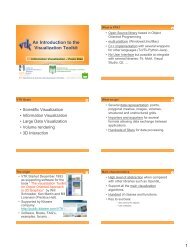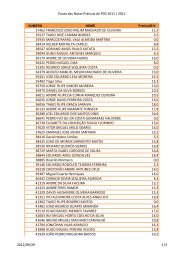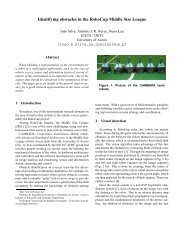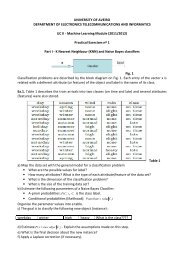Reuse Technique in Hardware Design - Sweet
Reuse Technique in Hardware Design - Sweet
Reuse Technique in Hardware Design - Sweet
Create successful ePaper yourself
Turn your PDF publications into a flip-book with our unique Google optimized e-Paper software.
4. Customization of RHFSM functionality is achieved<br />
through reload<strong>in</strong>g its RAM blocks with the aid of<br />
methods [12].<br />
5. Reusability of modules can be provided apply<strong>in</strong>g the<br />
same technique which is widely employed <strong>in</strong> software<br />
eng<strong>in</strong>eer<strong>in</strong>g.<br />
6. The considered models can be retargeted to any<br />
desired level of specification, such as general-purpose<br />
languages, system-level specification languages and<br />
hardware description languages. Thus, any design flow<br />
discussed <strong>in</strong> section 2 can be supported.<br />
7. Software models enable the designers to use generalpurpose<br />
computers to generate customization bitstreams<br />
and to verify the projects.<br />
The follow<strong>in</strong>g list summarizes advantages of the<br />
proposed reuse technique for hardware design:<br />
• It permits to realize highly optimized and carefully<br />
tested design templates for vast varieties of similar<br />
problems.<br />
• The designed circuits can be made adaptable to<br />
different external conditions. Indeed, dependently on<br />
external events the circuit can be properly modified,<br />
select<strong>in</strong>g an adequate module.<br />
• The designed circuits can be made virtual <strong>in</strong> such a<br />
way that we can implement functionality <strong>in</strong> FPGA that<br />
does not possess sufficient hardware resources. This can<br />
be achieved through proper sequential reconfiguration,<br />
which is allowed for the considered models.<br />
5. Conclusion<br />
The paper describes a reuse technique that can be<br />
applied to the design of FPGA-based, application-specific<br />
digital systems. Reusability is achieved at the follow<strong>in</strong>g<br />
two levels. First, the considered circuits (hardware<br />
templates) can be constructed <strong>in</strong> such a way that allows<br />
the same hardware to be employed for different types of<br />
closely related functionalities. Thus, reusability at the<br />
level of hardware circuits is provided. Second, the<br />
proposed specification and implementation methods<br />
(namely HGSs and HFSMs) enable the description<br />
fragments (or modules) to be employed <strong>in</strong> such a way that<br />
the developed algorithm is composed of novel and<br />
previously designed modules. Thus, reusability at the<br />
level of specifications is provided. F<strong>in</strong>ally, the <strong>in</strong>tegrated<br />
reuse technique is proposed.<br />
6. References<br />
[1] G. Estr<strong>in</strong>, “Organization of Computer Systems – The Fixed<br />
Plus Variable Structure Computer”, <strong>in</strong> Proc. Western Jo<strong>in</strong>t<br />
Computer Conf., New York, 1960, pp. 33-40.<br />
[2] EE Times (2006, May 30), “Semiconductor FPGA/PLD<br />
market to grow 14% <strong>in</strong> '06” [Onl<strong>in</strong>e]. Available:<br />
http://www.eetasia.com/<br />
ART_8800419580_499485_0e42dd84200605.HTM.<br />
[3] EE Times (2006, May 24), “FPGA Market Will Reach $2.75<br />
Billion by Decade's End” [Onl<strong>in</strong>e]. Available:<br />
http://www.us.design-reuse.com/news/news13441.html.<br />
[4] Virtex-5 LX Platform Overview (May, 2006) [Onl<strong>in</strong>e].<br />
Available:<br />
http://direct.xil<strong>in</strong>x.com/bvdocs/publications/ds100.pdf.<br />
[5] Altera Product Catalog. October 2006. Available at:<br />
http://www.altera.co.jp/literature/sg/product-catalog.pdf.<br />
[6] Available at: http://www.<strong>in</strong>tel.com/technology/<br />
mooreslaw/<strong>in</strong>dex.htm.<br />
[7] Available at: http://www.xil<strong>in</strong>x.com/.<br />
[8] EE Times (2006, July 31), R. Goer<strong>in</strong>g, “FPGA users rank<br />
challenges, tasks”.<br />
[9] International Technology Roadmap for Semiconductors,<br />
System Drivers, 2005.<br />
[10] International Technology Roadmap for Semiconductors,<br />
<strong>Design</strong>, 2005.<br />
[11] V.Sklyarov, I.Skliarova. “<strong>Design</strong> of Digital Circuits on the<br />
Basis of <strong>Hardware</strong> Templates”. Proceed<strong>in</strong>gs of International<br />
Conference on Embedded Systems and Applications – ESA’03,<br />
Las Vegas, USA, CSREA Press, June, 2003, pp. 56-62.<br />
[12] V.Sklyarov, “Reconfigurable models of f<strong>in</strong>ite state<br />
mach<strong>in</strong>es and their implementation <strong>in</strong> FPGAs”, Journal of<br />
Systems Architecture, 2002, 47, pp. 1043-1064.<br />
[13] I. Skliarova, V. Sklyarov, "<strong>Design</strong> Methods for FPGAbased<br />
Implementation of Comb<strong>in</strong>atorial Search Algorithms",<br />
Proc. Int. Workshop on SoC and MCSoC <strong>Design</strong> -<br />
IWSOC'2006, 4th Int. Conference on Advances <strong>in</strong> Mobile<br />
Comput<strong>in</strong>g and Multimedia - MoMM'2006, Yogyakarta,<br />
Indonesia, December 2006, pp. 359-368.<br />
[14] V.Sklyarov, “FPGA-based implementation of recursive<br />
algorithms”, Microprocessors and Microsystems, Special Issue<br />
on FPGAs: Applications and <strong>Design</strong>s, 2004, 28/5-6, pp. 197-<br />
211.<br />
[15] V. Sklyarov, I. Skliarova, B. Pimentel, "Us<strong>in</strong>g<br />
Compression/Decompression <strong>Technique</strong> for FPGA Targeted<br />
Matrix-Oriented SAT Solvers", Proc. XX Conference on <strong>Design</strong><br />
of Circuits and Integrated Systems - DCIS2005, Lisbon,<br />
Portugal, November 2005.<br />
[16] V.Sklyarov, “Hierarchical F<strong>in</strong>ite-State Mach<strong>in</strong>es and their<br />
Use for Digital Control”, IEEE Trans. on VLSI Systems, 1999,<br />
vol. 7, no 2, pp. 222-228.



